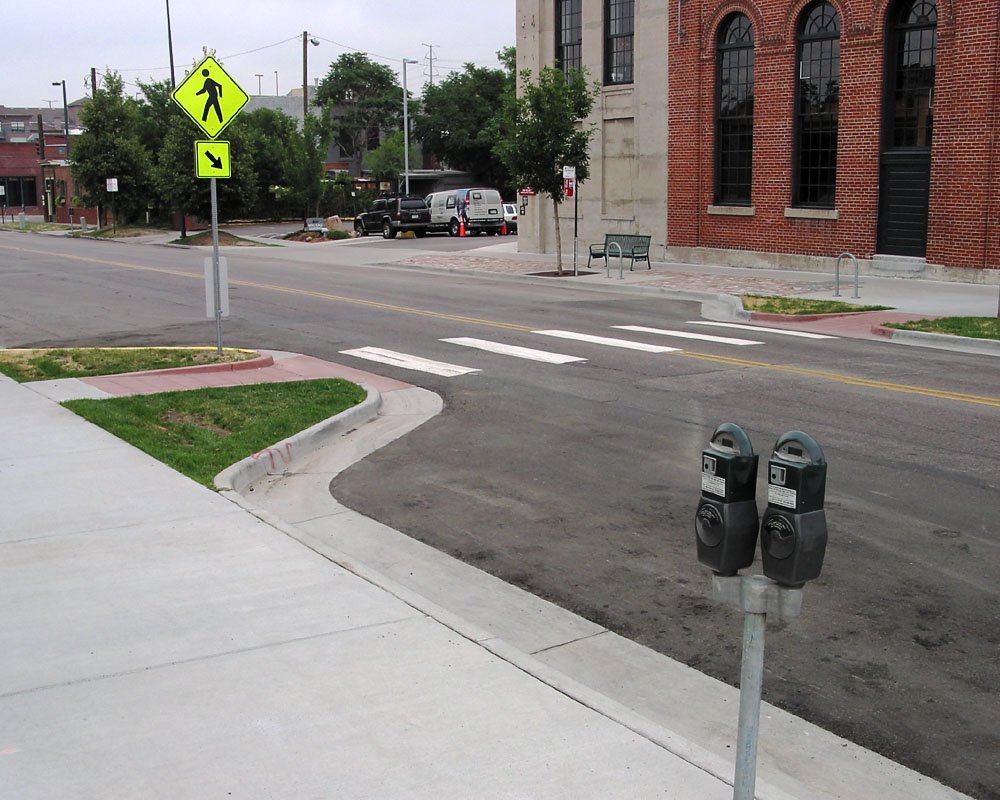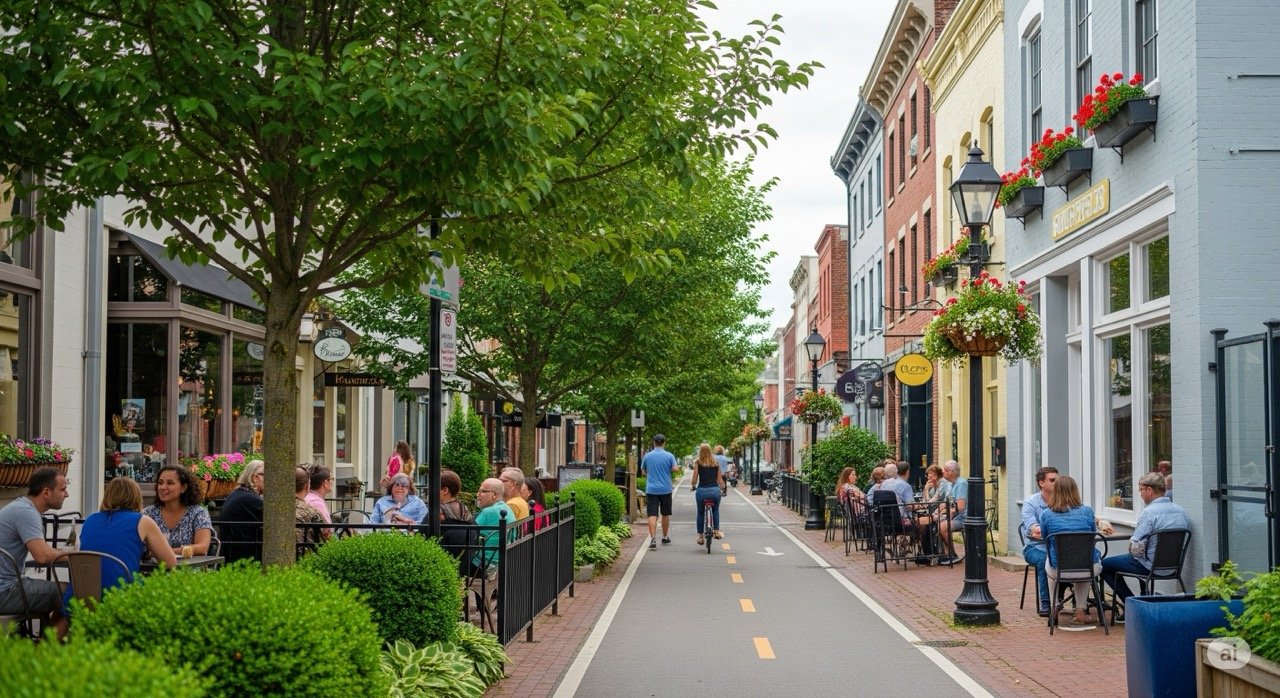Last week, the Ontario Government announced a bold shift in road safety policy: scrapping speed cameras in favor of funding traffic calming measures like speed bumps, curb extensions, roundabouts, and flashing signs.

At Strong Towns Kingsville, we support this move. While speed cameras may act as a temporary fix, they’re merely a bandaid.
As outlined in our Strong Towns philosophy, real solutions lie in better road design and fostering a cultural shift toward safer driving behaviors. For evidence-based support, read “Evidence of Superiority of Traffic Calming Over Speed Cameras” at the end of this post.
This policy change aligns with the needs of our community. Kingsville’s 2022 Comprehensive Transportation Master Plan highlighted that:
“Many residents are concerned about dangerous driving along neighbourhood streets and would like to see measures implemented to help slow traffic and prioritize streets for people walking and cycling.”
This concern remains evident today, with citizens recording and posting acts of speeding in school zones and drivers failing to stop for school buses.
The good news? Kingsville could be eligible for provincial traffic calming funding if we can identify high-need areas, such as school zones or residential streets with speeding issues, and demonstrate clear road safety benefits like reduced speeds and enhanced pedestrian safety.
This is a time-sensitive opportunity to make our streets safer and more inviting for everyone.
What Strong Towns Kingsville Is Doing
We are already taking action to ensure Kingsville seizes this opportunity:
- Cataloging Dangerous Areas: Our team is actively documenting hazardous pedestrian crossings and high-risk streets, compiling a report to submit to the Town Administration. This report will strengthen Kingsville’s case for securing provincial funding.
- Engaging the Community: We’re organizing community walks to identify problem areas and involve residents in designing safer, more livable streets. These efforts foster collaboration and ensure our streets reflect the needs of our community.
- Highlighting Local Needs: For example, the area along the West side of Lakeside Park, is one of many areas we’re prioritizing for improvement.
How You Can Help
While the provincial funds are not yet available, Kingsville can get a head start. As a citizen, you can make a difference by:
1 – Contact Your MPP: Email MPP Anthony Leardi at anthony.leardi@pc.ola.org to express your support for traffic calming measures in Kingsville. Let him know that safer streets are a priority for our community—not only for safety, but for the freedom of of those who don’t drive, and to make downtown streets friendlier for shopping, dining, and tourism.
2 – Join Our Efforts: Participate in our upcoming community walks and monthly meetups to help identify problem areas and propose solutions. Together, we can make Kingsville’s streets safer for walking, cycling, and living.
3 – Spread the Word: Share this post with friends, neighbors, and local businesses to build momentum for safer, more vibrant streets.
Traffic calming measures don’t just improve safety—they also:
- make our neighborhoods more livable
- encourage active transportation
- boost local businesses by creating pedestrian-friendly environments
Let’s work together to ensure Kingsville secures this funding and transforms our streets for the better.
Thank you for supporting Strong Towns Kingsville and our mission to create a safer, stronger community.
Chad Nantais
Local Leader – Strong Towns Kingsville
Evidence of Superiority of Traffic Calming Over Speed Cameras
While both traffic calming and speed cameras are effective speed reduction tools, studies suggest that traffic calming measures offer superior, more persistent long-term safety benefits due to their reliance on passive, self-enforcing infrastructure changes rather than enforcement.
Here are three key datapoints supporting the long-term safety advantages of traffic calming:
- Greater Percentage Reduction in Personal Injury Accidents (PIA):
- Data: A comparative study on 30 mph roads found that engineering schemes incorporating vertical deflections (like speed humps or speed cushions) resulted in an average reduction in Personal Injury Accidents (PIAs) of 44%. This was twice the reduction found at sites where safety cameras were used, which averaged a 22% fall in PIAs [1].
- Implication: Physical changes to the road are more effective at eliminating accident-causing behaviors than enforcement alone.
- Permanent, Self-Enforcing Speed Reduction:
- Data: Traffic calming measures, by their nature, are self-explaining and self-enforcing, meaning drivers must slow down to maintain comfort and avoid vehicle damage, irrespective of enforcement presence [2]. For example, one FHWA study on speed humps showed that the proportion of traffic traveling more than 10 mph over the limit dropped from 14% before installation to an average of 1% after installation [3].
- Implication: This structural change creates a lasting behavioral change across the entire road segment, whereas the safety effects of speed cameras can be highly localized and may rely on drivers’ awareness of the camera’s location (“halo effect”) [4].
- Significant Impact on Fatal and Serious Accidents (Severity):
- Data: The same comparative study noted that schemes with vertical deflections were the only type of scheme to have a significant impact on fatal and serious accidents [1]. Furthermore, a systematic literature review concluded that traffic calming interventions consistently reduce both the frequency and severity of collisions [5]. For instance, a study found a 53−60% reduction in the odds of injury or death for children struck by vehicles in neighborhoods with traffic calming [6].
- Implication: Traffic calming not only reduces the chance of a crash but fundamentally lowers the kinetic energy of a collision, which is the key factor in determining injury severity and long-term public health outcomes.
Citations:
[1] Allsop, P. (2004). Are speed enforcement cameras more effective than other speed management measures? The impact of speed management schemes on 30 mph roads. ResearchGate.
[2] Road Safety Toolkit. Speed Management and Traffic Calming. (The “self-explaining and self-enforcing” principle of traffic calming).
[3] Federal Highway Administration (FHWA). Module 4: Effects of Traffic Calming Measures on Motor Vehicle Speed and Volume. (Data on speed hump effectiveness on high-speed vehicles).
[4] Insurance Institute for Highway Safety (IIHS). (2015, October 1). Speed cameras reduce injury crashes in Maryland county, IIHS study shows. (Discusses the localized nature of camera effects and the need for “corridors” to enforce speed over a wider area).
[5] MDPI. (2023). Beyond Speed Reduction: A Systematic Literature Review of Traffic-Calming Effects on Public Health, Travel Behaviour, and Urban Liveability. (Notes the consistent reduction in frequency and severity of collisions).
[6] Traffic Logix. Multiple studies found traffic calming solutions reduce speeds, prevent crashes, and save lives. (Citing American Journal of Public Health data on injury/death reduction for children near speed humps).



Leave a Reply